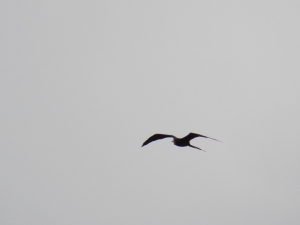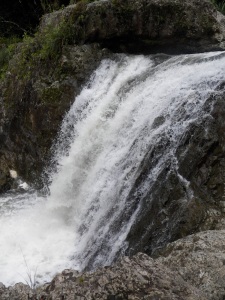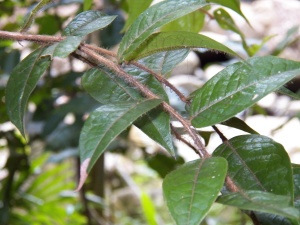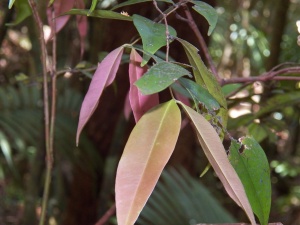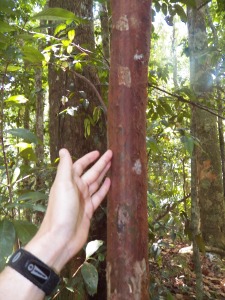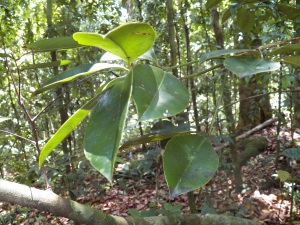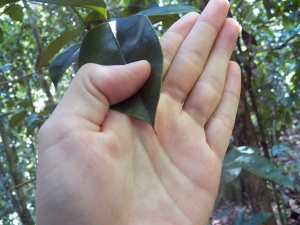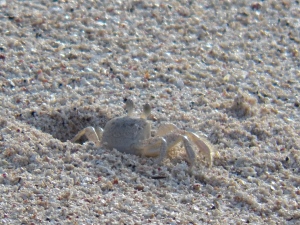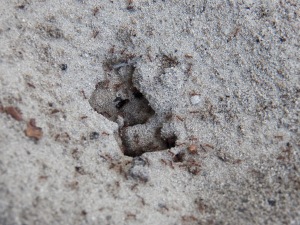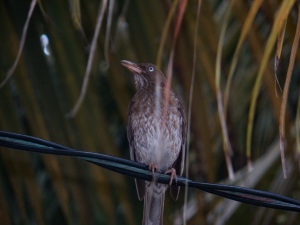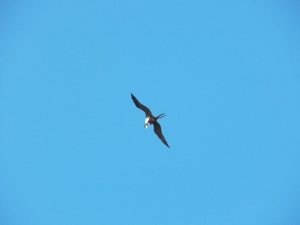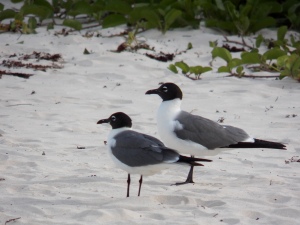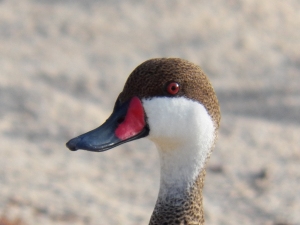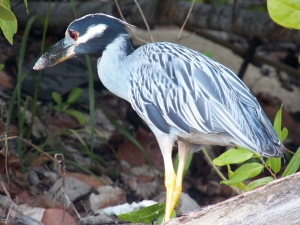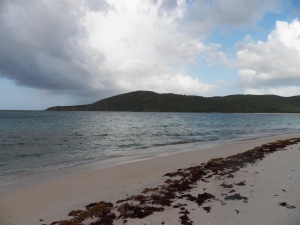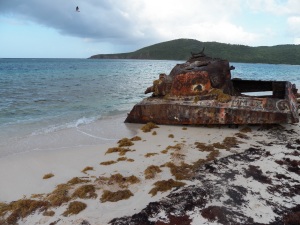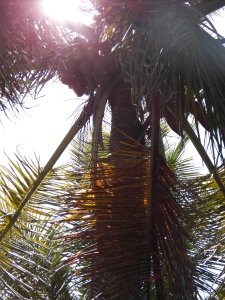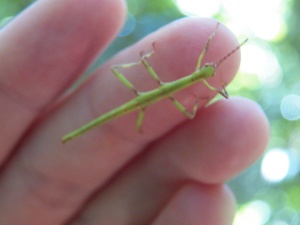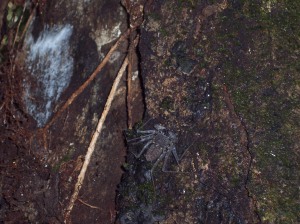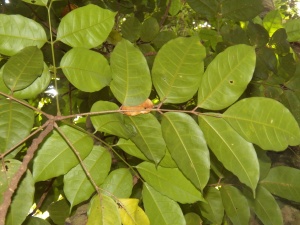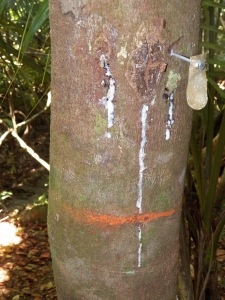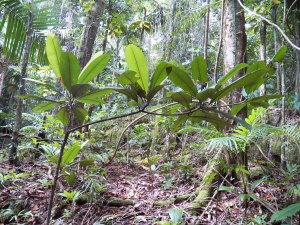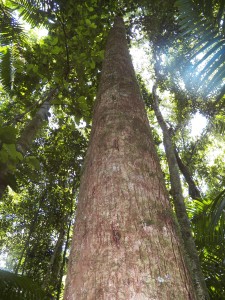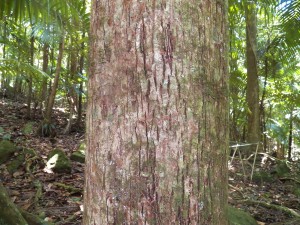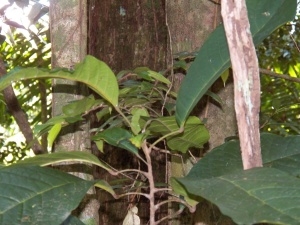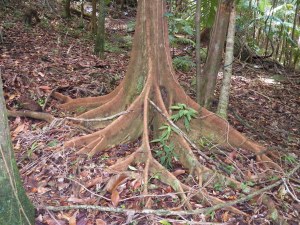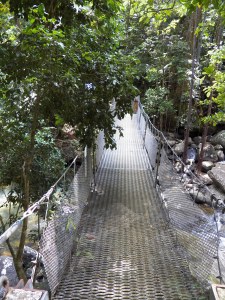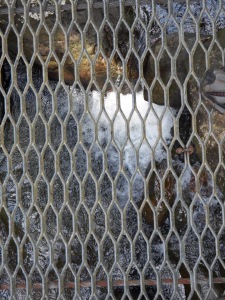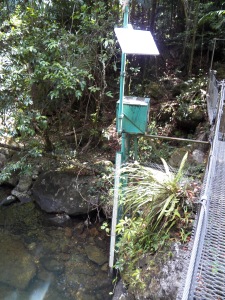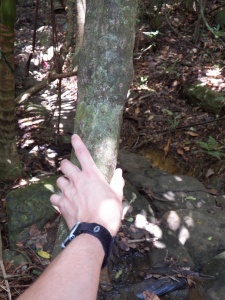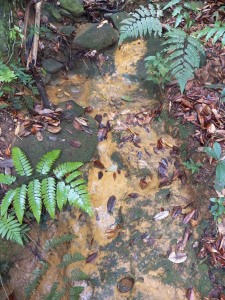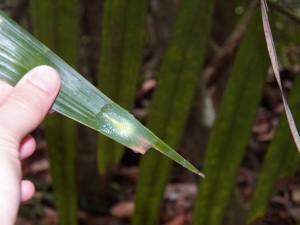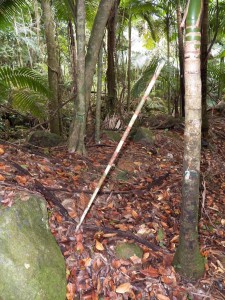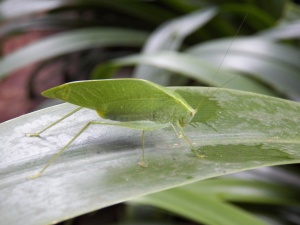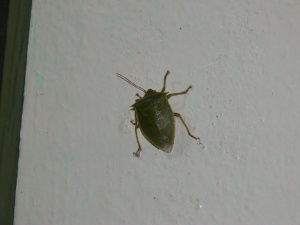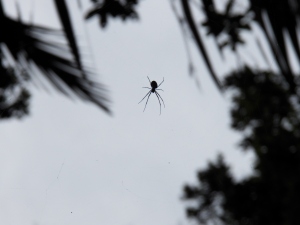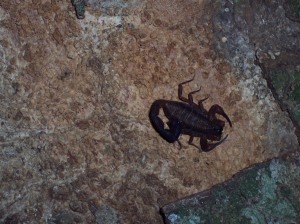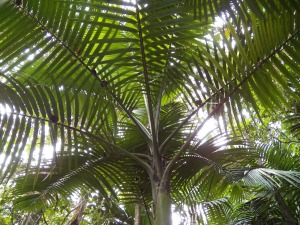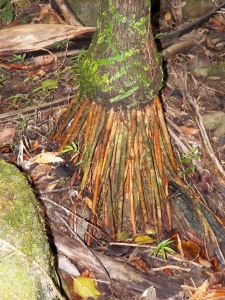A Day Trip to Ponce
A bunch of us still left at the station (tree census crew and a few chronosequence folks) left early this morning to go across the island to Ponce and a few other areas nearby. At 8:30, we loaded into a rental van and got on our way. After a couple of circles and u-turns in San Juan, as well as the revelation that Puerto Rican speed limits are in MPH and distance posts are in kilometers, we made it to our first stop in Guavate to pick up lunch. Guavate is known for their roast pork, so we stopped at a place right off the highway. We walked in and ordered a couple of pounds (they recommend 1/2 a pound per person) and got to see one of the guys working there take a fresh bit off a whole pig on a spit in the kitchen. He then cut it up in true Puerto Rican fashion, with a machete.
After this stop, we made our way to Ponce with our lunch. As we entered the city, we saw huge letters spelling PONCE across the highway, each on its own separated by several lanes. We shortly made it to the beach and enjoyed lunch in the shade of some trees right on the sand. The pork was delicious and melted right off the bone. The skin was crispy and salty. It was an excellent meal, but so fatty that I think it would be best for my health to go a few months before having any more. I made sure to take out my camera after lunch to get some pictures of the birds flying over us, including several frigatebirds. The one in this picture is a male, as it has the red gular sac.
This beach had a boardwalk adjacent to it, which went along a small marina. There were tons of birds flying and fish swimming around feeding on the food people dropped (or likely fed to them) into the water. I’ll post pictures of these in another post in the next few days. There was a small tower at one end of the boardwalk with stairs up to the top. Walking up to the top, we could get a good look down below us, out to a few islands off the coast, and inland at the mountains we had crossed to get to Ponce.
After walking the length of the boardwalk (it was lined with restaurants and bars), we got back in the van to head into downtown Ponce. There was some sort of festival going on in the central plaza, so we parked and walked over to a nearby ice cream shop. The ice cream there was homemade and reminded me a lot of the ices from Lemon Ice King of Corona. Across the street was the old Ponce firehouse, a brightly-colored building made entirely of wood. This is really unusual on an island where most structures are build of concrete to withstand the elements.
After a walk around one of the touristy shops and the fountain in the center of the plaza, we headed back to the vans to travel to our final destination of the day. We traveled a bit north to Adjuntas, where there was a swimming area on a good-sized river. The area was nice, but I stayed up on the rocks while some of the others were enjoying a nice 30+ foot jump into one of the pools below a few waterfalls.
Following this adventure, we finally headed back across the island and I got to finish the leftover pork for dinner. Nothing like Puerto Rican food to make you feel healthy.
Starting Row 5
As I mentioned in my last post, we finished rows 3 and 4 in the grid, so we have moved on to rows 5 and 6. The six of us are divided in two teams and my team is working on row 5. To get to the beginning of row 5, we had to walk along a ridge and then go down into a valley with an intermittent stream in it. Unfortunately, the banks of this valley are not rocky as they are elsewhere in the grid, but muddy.
The soil is completely saturated and covered in leaf litter, so you never quite know when you are about to find yourself rapidly sliding down the hill. The only good way I have found to make it down or up these slopes is to walk on exposed roots or rocks, grab onto sturdy-looking trees, or try to find a wide area of level ground. Anywhere else on these slopes and it would be a quick slide down to the bottom. So far, my techniques have worked and I have avoided any large slides.
To add to this muddy terrain we found ourselves getting clipped by some of the outer bands of Tropical Storm Emily last week. We got very little in the way of wind, but a fair bit of pouring rain. As a result, we deemed it unsafe to work in the field and stayed inside to enter data into the computer database on Tuesday and Wednesday. By Thursday, we were back out in the woods, darting from tree to tree on the slope, measuring trees.
One of the first trees we came to on Thursday was a small SLOBER with a sprout. As such, it had a tag for both the main stem and the sprout. When we got close, one of my coworkers said that there appeared to be some sort of cocoon between both of the tags (of course with both numbered sides facing in). Upon separating them, he quickly realized that it was not a cocoon, but a web of a small tarantula (only about 2 inches long). We caught it in a lunch bag and brought it back to the field station to show others. I didn’t manage to get a picture of it, but I’ll describe it as hairy and mostly brown, with stunning blue on some of its distal leg segments.
We released the tarantula back where we found it on Friday, then finished a few more quadrats with the exception of a few larger trees. We have had several trees in the beginning of this row that need to be measured higher than we can do without ladders (up to about 4 meters up). As such, the last thing we did on Friday was bring the ladder closer to those plots. We figure it might be better to wait for a dry week before trying to get the ladder down the muddy hillside.
An additional note: I’ve decided to stay on here in Puerto Rico until December! So expect several more posts and new and interesting trees as we get further into the grid.
These are three generally small trees commonly found in the area we’ve been in this past week at the far end of row 3. We finished data collection in rows 3 and 4 this week, so we’re about 16% of the way through.
HIRRUG, (Hirtella rugosa), Teta de Burra Cimarrona
This is a fairly common tree in the grid so far, with it entirely taking over some plots in the higher quadrats. It is distinctive with it’s hairy branches and leaves. We’ve been told that some people refer to it as “Hairy Mary”, though this seems to be limited to people at the field station.
MYRLEP, (Myrcia leptoclada), Guayabacon
This small tree or shrub is a common occurrence throughout the part of the grid we’ve seen so far. It usually has distinctive pinkish new leaves at the end of its branches, though when it doesn’t it can be a real issue to identify it.
Larger stems have a strange peeling bark. The outer layer is like thin, reddish paper, while the inside is green.
RHEPOR, (Rheedia portoricensis), Palo de Cruz
Note: What I could find online suggests that this plant is now known officially as Garcinia portoricensis.
This is a small tree that is limited to the highest parts of the big grid at the end of the first few rows. It has fairly thick leaves with a distinct feature that you want to know about before you get too close.
There are small, sharp spines at the tip of the leaves (a trait that only this tree has in the big grid, thankfully). Walking through a small grove of these is bound to get you pricked by a spine or two, though they aren’t terrible if you approach them slowly.
Fauna of Puerto Rico: Part 4 (Culebra)
I’m going to preface this post by saying that I didn’t have my camera available for a lot of the cool stuff I saw on Culebra, so I’m only going to post about the things for which I have pictures. If I get a picture of them, I’ll post about them down the line. Things to look forward to in another post (perhaps): Brown Pelican, Common Ground Dove, Zenaida Dove, House Sparrow and Rock Pigeon (if I get desperate).
Ghost Crabs, Ocypode spp., Ocypodidae, Decapoda
These crabs are common denizens of beaches. They live in small burrows in the sand and are most active at night. They are omnivorous, eating anything from clams to beach debris. We had one living in our campsite that I watched excavate its burrow around 1 in the morning. The males have one claw that is larger than the other. The one in this picture was out on the beach next to the campsite.
Fire Ants, Solenopsis spp., Formicidae, Hymenoptera
There were several large anthills (about a foot in diameter) around the campground. They were easy enough to avoid if you were looking, but I mistakenly stepped too near one or two of them and was immediately bitten several times on my feet and ankles. The bites of these fire ants are relatively bothersome and sting a good bit. They are highly territorial and feed on anything they can find. They are just a fact of life in the tropics and will be happy to finish up any food you drop on the ground.
Pearly-eyed Thrasher, Margarops fuscatus, Mimidae, Passeriformes
These birds are fairly common all over Puerto Rico. I have seen them at the field station and saw plenty on Culebra. They are good-sized (comparable to a robin) omnivores and have a varied song like mockingbirds in the same family Mimidae.
Black-faced Grassquit, Tiaris bicolor, Thraupidae, Passeriformes
These dull-colored birds flew through the brush outside our campsite, so I got a picture and came back to the internet to ID them. Grassquits are herbivorous, feeding on seeds. They are small birds that are common throughout the Caribbean.
Magnificent Frigatebird, Fregata magnificens, Fregatidae, Pelecaniformes
Despite my many attempts, I could not get a very clear picture of a frigatebird. They were constantly high up and moving quickly, once even getting mobbed my a bunch of small birds over the beach. I saw easily half a dozen of them.
Frigatebirds are distinctive seabirds with a long tail and thin, sharp wings. The males have a red gular sac on the neck. They feed on sea creatures, especially fish, without ever entering the water. Unlike most birds, frigatebirds don’t produce much oil to keep their feathers waterproof. As such, much of their life is spent aloft, soaring on thermals and snatching fish from the water surface. They are known kleptoparasites, meaning that they will steal food from other seabirds.
Laughing Gull, Leucophaeus atricilla, Laridae, Charadriiformes
The laughing gull is the most common gull in Puerto Rico and Culebra. They are entirely black, white, and gray, except for a bit of red on the bill. They have black heads and black feet, as well as dark tails and wings. Like all gulls, they are omnivorous, feeding on anything they can find along the shore from beached fish and crabs, to camping leftovers.
White-Cheeked Pintail, Anas bahamensis, Anatidae, Anseriformes
These ducks have a spotted brown body, solid brown head, white cheek, as well as a red and blue bill. The are dabbling ducks, feeding on aquatic plants and small creatures just under the water surface. I saw several of them flying over the bay as well as these two which were on the beach.
Here’s a better look at the red and blue bill. They also have a red eye that stares deep into your soul.
Yellow-Crowned Night Heron, Nyctanassa violacea, Ardeidae, Pelicaniformes
There was at least one of these that kept coming back and walking along the dunes past our campsite. Like all herons, night herons are typically sit-and-wait predators, standing in the shallows waiting to quickly spear small fish or crustaceans unfortunate enough to come past. They are primarily nocturnal, though I had no problem finding this one during the day.
A Trip to Culebra
After working every weekday since arriving in Puerto Rico (including 2 holidays), we decided to take a short vacation for three days (we’ll work on the holidays next week; there are apparently 4 holidays in July in PR). Our destination was the island of Culebra, between Puerto Rico and the U.S. Virgin Islands. The island is part of Puerto Rico, and is accessible by ferry from the Fajardo (about 40 minutes away from the field station).
On Wednesday morning, we all got up early (the entire tree census team and our field tech) and left the field station around 6:30 with one of the grad students driving us to the port. After getting dropped off, we got in a line that wrapped around the block from the ticket window. After about 15 minutes, an announcement came over the loudspeakers that the 9:00 ferry was completely sold out, and that the next ferry would be at 3:30 that afternoon.
We didn’t really want to wait around at the ferry terminal for so many hours, so we considered our options. We could take a ferry to Vieques (another island off the coast), but we didn’t know much about it, and it would be more difficult from a logistical perspective to go in blind. There were a bunch of taxi drivers going about the crowd, telling us that we could fly to Culebra from nearby Ceiba Airport. We settled on this, since the cost wasn’t too bad (though considerably more than the $4 ferry ride).
We got in one of the taxis and drove along down the road towards the airport. After a while, we ended up on these empty back roads. We were getting a bit nervous about the reputability of this airport (let alone our taxi driver), when the terminal came into sight. We payed the driver, grabbed our gear, and walked into the terminal. The building wasn’t anything fancy, essentially just a big warehouse-type building with a few rows of seats and a ticket window. However, the building had air conditioning, which was fantastic on this rather warm day (we’re a bit spoiled up at the cool mountain field station). We signed up for the wait list with our names and our weights, then weighed our bags and sat down in a row of seats. As we were waiting, we heard the distinct rush of rain on a large warehouse-type roof and looked outside to see it pouring. Probably a good thing we weren’t waiting at the ferry terminal after all. It stopped after a few minutes, as it usually does.
Eventually, our names were called and we went up to buy our tickets. We then headed over to the other side of the terminal with windows looking out on the runways. There wasn’t any sort of security check or hassle like at a major airport in the states; we simply walked over and sat there. After a bit more time, we were called again and we walked out to our waiting plane.
Now, this was no huge 747. We were to take an 8-passenger plane across the ocean to the island. We were given assigned seats based on our weight, so the plane would fly level. Packed like sardines with seat belts fastened, we took off at a gallop towards the runway. With so little plane traffic, there was no need to slowly taxi and build up speed. The pilot simply started going at highway speed around the airport roads to the runway. We took off without issue and got to look down as the land was shrinking away below us. Then, we were over the water. It was the beautiful blue color that you always see in those pictures of Caribbean beaches. After about 15 minutes, we were approaching Culebra. Looking out the front of the plane, all I could see was a few mountains and no sign of an airport. We steered right towards a mountain, then banked a bit to the right to pass between it and another. At this point, the runway finally came into view, and we hit the tarmac softly.
We left the airport (nothing more than a runway and a small building that we were through in 30 steps) and headed into town to rent bikes. I saw several neat birds along the way including a pelican, some doves, and even a frigatebird (more on the birds in another post). We got to the bike shop, talked to the owner for a bit, and then left with 6 bikes to get us up to the campsite at Flamenco Beach. After riding back past the airport and over a few small hills, the heat and the intensity of the sun, combined with the weight and discomfort of my backpack, left me feeling pretty beat. I don’t know exactly how warm it was, but I’d estimate it to have been somewhere between 90 and a billion degrees. We arrived at the campground, checked in and headed to our campsite at the far end of the beach. After setting up camp, I promptly slept away most of the afternoon and evening in the shade. Despite my ability to deal with walking to class when it’s -15, I don’t have a high tolerance for the heat and humidity. After dinner and making a small campfire, I was off to try to sleep on a uncomfortable sleeping pad in a way-too-hot-and-stuffy tent.
Following a less-than-restful night, I decided to stay around camp and hang out, while some of the others went to another beach on the bikes. I walked out from our campsite to the other side of the trees to see this:
This picture was actually taken later, when it was cloudy, but I assure you that the scene was even more grand than this. The water was that wonderful Caribbean blue and some hills rose up on the other side of the bay. Turning to my left, I saw a large chunk of metal some distance off.
Apparently, the U.S. Navy used the island for practice military exercises from World War II through the 1960s. They left a few tanks on the beaches, which have become strange rusted relics. There was another tank further inland by the campsites.
I walked up and down the beach for a bit with my camera, taking some pictures of the wildlife and the bay, before heading back to the campsite to hide in the shade and take a nap. On the edge of our campsite, and lining the dunes along the beach, were some coconut palms with plenty of coconuts in them.
The following day, we took down our campsite and biked back to town to return the bikes, get lunch, and get to the ferry. We got lunch at this little restaurant/bar behind the bike shop right on the edge of the water. There were several large fish swimming around (we were told they were tarpon), but sadly I didn’t have my camera accessible.
After lunch, we walked down to the ferry terminal to wait around before the line started to buy tickets. For whatever reason, you cannot buy tickets until an hour before the ferry leaves, so we waited around from 2:30 to 4:00 to ensure that we got tickets. We bought tickets (pretty reasonable at $2.25 per person) and got in line to board the ferry, which hadn’t yet arrived. The ferry arrived around 5:00 full of passengers visiting Culebra for the 3-day weekend. Since it had started raining just before they disembarked, they were a little slow to do so, waiting under the overhang for the rain to slow down. Finally, after they had all left, we were allowed to board.
We got seats near the exit (so we could get off quickly in Fajardo) and the ferry was soon underway. A few minutes in, a few of us got up to explore the boat a little and see of we could get outside. We found our way to the stern where we had boarded and stood at the railing, watching the ocean fly by ahead of us while breathing in the exhaust from the engine. It was a pleasant trip nonetheless, and after some careful repositioning, I managed to get away from the brunt of the exhaust. A bit over an hour later, we were approaching Puerto Rico, so we returned to our seats, gathered our things, and headed off the boat once it reached the dock. After a bit of searching, we located the van and our grad student friend who would take us back to the station.
Overall a great few days. I’ll post plenty of pictures in my next post of the organisms I saw and had my camera on me at the time.
Fauna of Puerto Rico: Part 3
I’ve gotten a few more pictures of cool animals living here in the big grid. Including another bird species (!) and some more arthropods.
Bananaquit, (Coereba flaveola)
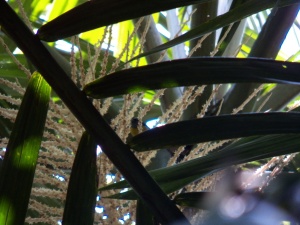
Alright, so the picture isn’t great, but I swear there is a bird right there in the middle. This is a bananaquit. They are supposedly pretty common, but are usually up in the canopy feeding on nectar, such as this one in a palm.
The can be identified by a yellow underside, dark head, and white eye-line. One of these days, I’ll get a decent picture of one and post more about them.
Phasmatodea, Stick Insects
Stick insects are fairly abundant around here, but you would never know it until they crawl right in front of you. They are masterful at crypsis and blend in with branches and bark of trees very well. I only caught this little guy because it was a green insect on a brown trunk.
They are herbivores, slowly grazing while shaking in the breeze just like a twig. Any predators coming after these guys must be very perceptive. They grow to pretty good size around here (we’ve seen some probably about 8 inches in length) but are usually relatively small, slender things (usually 2-3 inches long).
Amblypygi, Tail-less Whip Scorpion
This picture doesn’t really do it justice, but this is an amazing nocturnal insectivore. These are arachnids (together with scorpions and spiders) and are carnivorous. The feed mostly on insects (though I’ve read that big ones can will eat a coqui every now and then) by catching them with their spiny pedipalps (modified body segments in front of the mouth).
This guy was pretty small (maybe 3-4 inches in body length, with lots more in legs), but I’ve heard that they can get much bigger. Hopefully I’ll get a chance to see one like that and get a picture with my real camera and not my little field camera.
For the rest of this week, we’re planning to go to Culebra, which is an island off the coast of PR. I’ll be sure to take lots of pictures and post when I get back.
The climax forest here at the field station is the Tabonuco forest. This is the forest type which, barring disturbance, would eventually cover all of the land up here. These three tree species are some of the most common trees of the Tabonuco forest.
DACEXC, (Dacryodes excelsa), Tabonuco or Candlewood
DACEXC can get to be a pretty big tree (we’ve seen some with diameters greater than half a meter). They have pinnately compound leaves, such that the leaflets come off along a central stalk with a bud at the base. The leaflets are opposite, with a terminal leaflet on most leaves. However, these trees are much easier to ID when they are bigger, and you can see the trunk.
These trunks often produce a clear-white resin that oozes out of any holes in the stem (such as from a nail hole where a tag is attached). This resin has a strong smell, somewhat similar to resin of conifers back in the US. I can usually smell a big DACEXC before I can see it out in the woods.
MANBID, (Manilkara bidentata), Bulletwood
These trees have very thick simple leaves (they sort of look like rhododendron) and looping branches. They are pretty abundant in the relatively pristine southern portion of the Big Grid. We see plenty of them low to the ground about the size of the one in the picture above, but every now and then we get to see a big one.
These trunks are fairly distinct in this forest where most of the trees have rather smooth bark. The distinct vertical pattern of the bark and the reddish color help to identify them.
SLOBER, (Sloanea berteriana), Bullwood
The best way that I have for identifying these trees is to look at the leaf petiole. It is usually double-arced, with a big bulge where the second curve begins. The leaves are variable, but can get quite large, among the largest leaves I’ve seen.
Larger trees often have thin, reddish buttresses. The trunk itself may even be reddish near the base. We’ve seen plenty of these in the field (we had a couple of subplots with about a dozen SLOBERs in them). It is always amusing (in a fresh-out-of-college, immature way) that the species code for this tree is pronounced the same as “slobber”, which we call back and forth across the plot on a regular basis. The leaves do have a pretty long drip tip, so when it rains you don’t want to stand under a SLOBER, or you may get wet.
A Walk in the Woods
As I’ve previously mentioned, I work in the woods some distance away from the field station where I live. The only way to get to the Big Grid is on foot, along a rocky trail crisscrossed with dozens of small streambeds and a few flowing waterways. After leaving the station (by walking across a small stream that isn’t much more than a trickle except after rain), it is a short walk to the turn-off for the trail to the Big Grid. If you stay on the main trail, you end up at a swimming hole down on the Quebrada Sonadora.
Immediately after this turn, the ascent begins. Rocks, roots, and even some ancient-looking cinder blocks provide footholds up the relatively shallow slope that seems to never end. I usually just look down at the ground and tell myself that I need to save my energy for the rest of the hill, so that when I get to the top and see that I’ve made it, it’s a huge relief. This trail isn’t too bad if you are wide awake and not carrying anything, but at 8 in the morning with a full pack and some field gear, it can be a pretty grueling 3 minutes.
After reaching the top, you begin a slight decent into the valley. Hopping from dry rock to root, you make your way down around a few curves to the Quebrada Sonadora. This is the biggest river that flows across the trail.
The bridge is what looks like a hastily-thrown-together suspension bridge made from old chain-link fencing strung together with wire. Suffice to say, it isn’t the most immobile bridge, and bounces nicely under one’s weight.
Fortunately, the bridge isn’t very high above the water, and you can get a good look down into the stream. Four years of crossing bridges over deep gorges to get to class has sort of diminished my hesitance to cross and casually look around.
There’s even a USGS stream gauge here (makes me sentimental for my days of stream work last summer in New York).
After the bridge, it’s a short walk downhill to the start of the Big Grid. If you are lucky, you are working on a plot right near the beginning. However, you get consistently less lucky the more work you do, until you find yourself in column 16 (the trail enters the grid in 2).
After crossing a small stream at the end of row 1, there is a nice hill of wet rocks (that becomes an all-out stream during heavy rain as we found out on Friday). Climbing up this is a bit treacherous, so I usually take it slow and grab on to one of the vines hanging down.
If you are lucky enough to be near the end of a row (we finished row 2 this past week) you just stay on the trail up and up and up (the southeastern corner of the Big Grid is the highest in elevation), so you either have to cut off the trail and hike through the woods, or take the trail and then cut up a small gorge.
All of the beige-orange substrate in that picture is clay, which becomes very slick and will shift underfoot. It makes it challenging to get up, but I usually manage by grabbing vegetation/rocks/roots. Although sometimes you need to watch what fronds you’re grabbing.
That little blob there is one of the snails I mentioned before which has its shell inside its body. They are a bizarre chartreuse color, with the soft parts essentially transparent.
Finally, after a long trek through the woods, we reach our goal.
That leaning, orange and white striped pole demarcates the southwest corner of each quadrat. They all have numbered tags, so you always know where you are.
Finally, it’s time to start actually working.
Fauna of Puerto Rico: Part 2
I’m going to devote this post to some of the arthropods I’ve seen here, so if anyone is a bit bothered by insects or arachnids, you might not want to go through all the pictures I have here.
Tettigoniidae, Katydids
Katydids are relatives of grasshoppers and crickets, all within the order Orthoptera. They are distinguished by their very long antennae. Often, they are green to blend in with the vegetation they eat, but the ones around here take it up a notch. They are downright cryptic, mimicking green leaves right down to the venation. I have really enjoyed how common these are around here, often ending up in our kitchen (they seem to be attracted to light). The ones I’ve seen have been up to about 3 inches long. They are simple enough to pick up if you grab them by the back of the wing or the hind legs so they can’t jump away. I’ve looked at them with a magnifying glass (which they nonchalantly crawled over as I was holding it) and saw that they have very hard mandibles, as evidenced by the dark, nearly black, color of the keratin. They are able to fly, but it isn’t what I would call graceful or smooth (more of a slow, fluttering mass of wings).
Pentatomidae, Stink Bugs
Stink bugs (or at least this looked like one to me) are insects within the order Hemiptera, based on their piercing-sucking mouthparts. This family is characterized by having 5-segmented antennae and shield-shaped bodies. Many species produce a sort of odor to protect them from predators while they stick their straw-like mouth into a plant stem to suck out sugary water. I haven’t seen too many of these here, but this one landed on me in the kitchen and it was big enough that I could get a shot of it (about 1.5 inches).
Araneae, Spiders
Alright, I don’t know a lot about spider diversity. There are many spider families, and having never taken a class on spider biology, I missed out on learning most of them. This is the kind of spider that we see everywhere in the forest, often building webs at face level across all of the paths. I couldn’t really get a good picture of one with it’s color showing well, so I figured the back-lit one looked cool enough for my blog. In reality, these spiders come in a bunch of colors, but all have distinct orange spots on their undersides. The top side usually has lines extending the length of the body in green, black, or red. They aren’t very big (maybe 1.5 inches including legs), but they are abundant. I suppose they must feed well on all of the insects in the forest (all spiders are carnivorous, usually insectivorous), though as my coworker pointed out to me the other day, you never see one with any prey in its web. Their passive feeding strategy of sitting and waiting for some unfortunate small insect to fly into their web seems to work pretty well considering the number of webs strung around the woods. However, their passive strategy becomes a lot more active when there are a bunch of tree census volunteers crashing through their webs every day.
Scorpiones, Scorpions
We finally got to see a scorpion today! We had eaten lunch at the top of a ridge under a couple of big trees (DACEXC, but more on that in a later post) with peeling bark. As we got up to start working again, my coworker brushed against the side of the trunk and a piece of bark sloughed off. Under it, there was a sort of cockroach (one of these days I’ll get a picture to represent that order, but they’re fast) that bolted away under the bark. We pried off a few more pieces of bark and found this wonderful arachnid quietly sitting there underneath the bark. It seemed not to be bothered by our presence and made no effort to harm us (though we stood a good distance back).
This scorpion, since it was found under the bark of a tree, is probably in the family Buthidae, the bark scorpions. All scorpions are carnivores, mainly insectivores, like their fellow arachnid spiders. They catch prey with their claws and immobilize it with their stinger (which they also use for defense from potential predators). We’ve been told that these guys aren’t too dangerous, but it is still better to avoid them if possible.
There are so many neat arthropods here (I’ve really got a soft spot for insects especially) so I’ll hope to get more pictures and put them in a later Fauna of Puerto Rico post.
Trees of Puerto Rico: Part 2 (PREMON)
PREMON, (Prestoea acuminata var. montana), Sierran Palm
The PREMON is the most common large monocot in the Big Grid. All of the other large trees (with the exception of another palm) are dicots. The difference between monocots and dicots is taxonomic, as well as structural. They are different lineages of seed plants, with monocots having a seed with only one cotyledon (the energy source for the seed) and dicots having two. Their growth is different too, with monocots typically having lots of parallel veins in their leaves (think grass) as opposed to the more convoluted, curving veins in dicot leaves (think of a maple leave). The stems of monocots generally don’t have secondary growth (stem widening), but rely more on primary growth (stem lengthening), whereas dicots have a lot of secondary growth and even put on annual rings in locations with real seasons.
There are PREMONs in nearly every subplot we measure. Their tags are nailed in and taped around the tree, since falling fronds can displace the nail. Falling fronds are actually one of the more frightening things in the forest during windy days. Some of the fronds I’ve seen can be 10 feet long and the simply crash through anything in their way. It is best to avoid standing too near dead fronds on a windy day. Even on the ground, these fronds are dangerous, as they look like a sure footing, but you find yourself sliding off them or crunching through them as soon as you step on one.
The trunks of these trees are different from a typical smooth dicot trunk, since they are covered in leaf scars from past fronds. This leads to a sort of scaly look along most of the trunk, with the top smooth green at the base of the fronds.
PREMONs will often put out prop roots for support. These are generally small and the new ones can be bright red with small whitish bumps. It is always neat to see these trees in a plot, since it breaks up the monotony of just another tall tree with green leaf-shaped leaves. You just have to watch for falling fronds.
